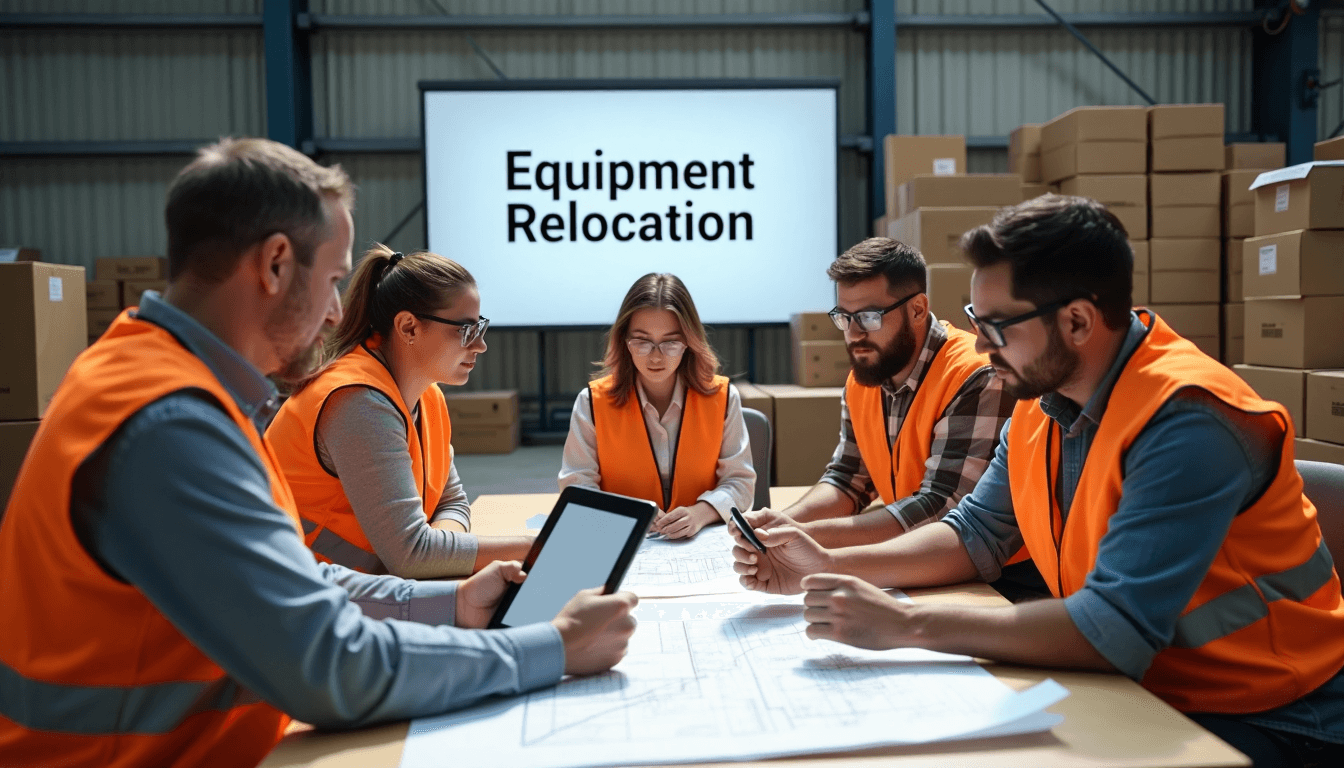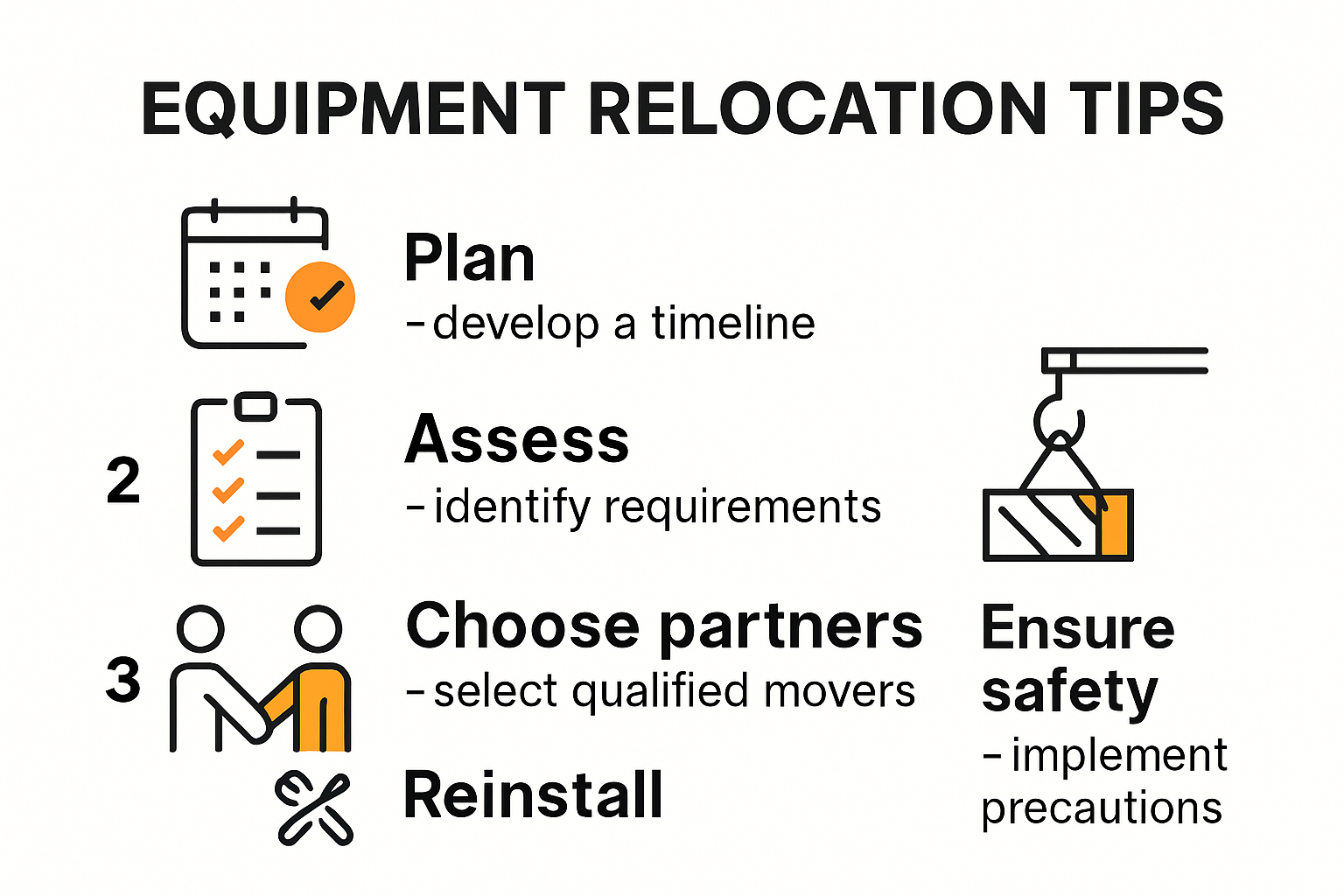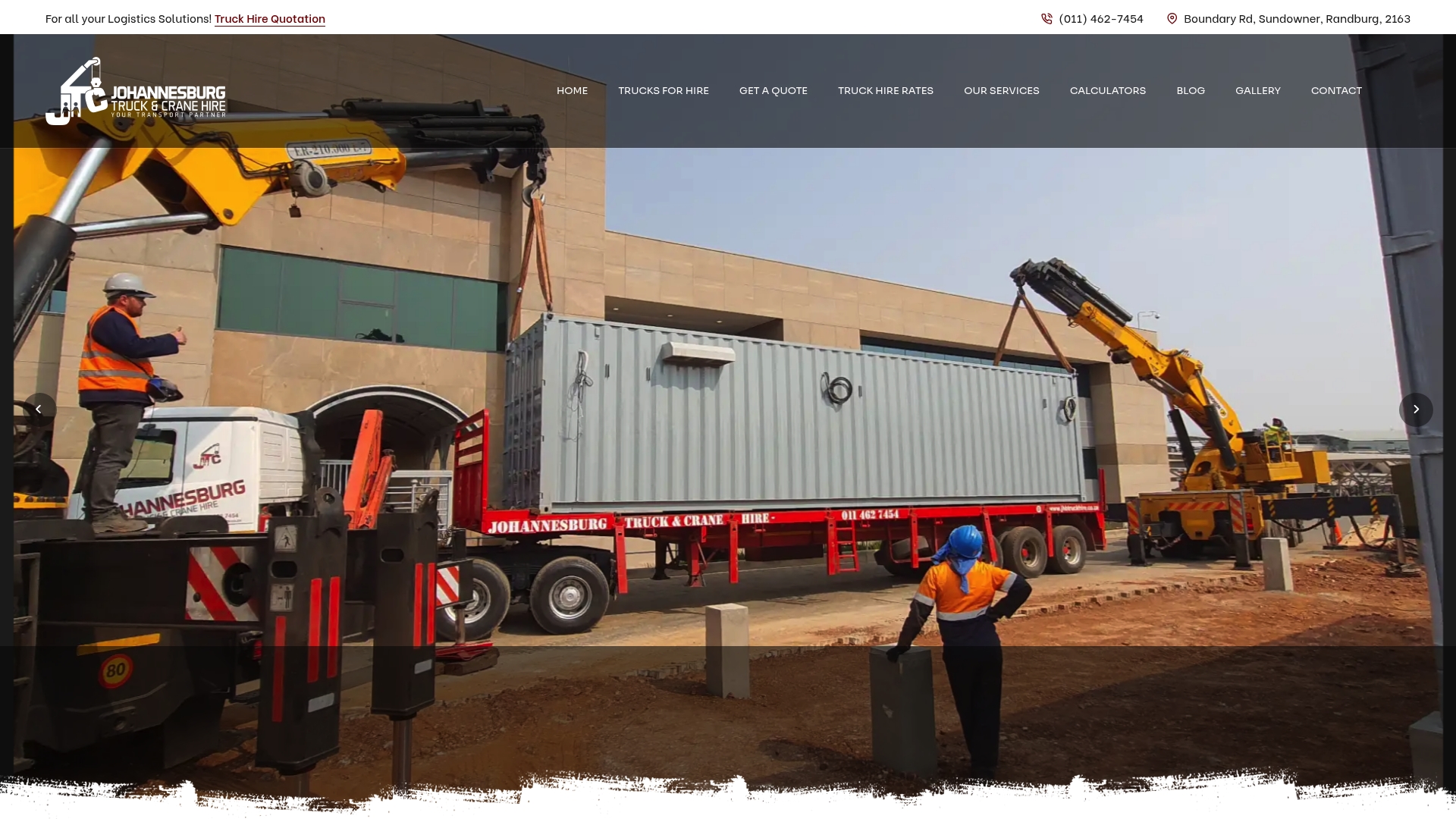
Moving industrial equipment is never just a matter of packing up and rolling out. The stakes are massive and even a small mistake can lead to major setbacks. Brace yourself. The South African heavy construction equipment market is expected to grow by 4.15 percent CAGR until 2029, making equipment moves more frequent and more high-stakes than ever. The real trick is not just getting machines from point A to point B. The secret that separates successful relocations from disaster is the planning that happens before anyone lifts a single tool. Here’s how the smartest teams avoid expensive downtime and keep their upgrades on track.
Planning Equipment Relocation For Your Industry
Establishing A Dedicated Relocation Management Team
Comprehensive Equipment Evaluation And Preparation
Choosing The Right Tools And Partners
Evaluating Specialized Moving Partners
Essential Equipment And Tools For Relocation
Strategic Partner Selection Process
Safety And Risk Management During Moves
Legal And Regulatory Compliance
Dynamic Risk Management Strategies
Ensuring Smooth Reinstallation And Startup
Comprehensive Pre-Installation Assessment
Precision Alignment And Calibration Protocols
Operational Startup And Performance Validation
| Takeaway | Explanation |
|---|---|
| Establish a Dedicated Relocation Management Team | A specialized team should include members from various departments to ensure comprehensive planning and risk assessment during the relocation process. |
| Conduct Comprehensive Equipment Evaluation and Preparation | Detailed assessments and documentation of equipment conditions, along with customized packing protocols, are crucial for a successful move. |
| Implement Strategic Downtime Management | Scheduling relocations during low-impact periods and allowing for partial operational continuity can significantly reduce disruptions. |
| Select Specialized Moving Partners | Choose moving partners based on their technical expertise, safety record, and compliance with legal standards to ensure a smooth transition. |
| Prioritize Safety and Compliance | Develop and maintain rigorous safety protocols and documentation during relocation to meet regulatory requirements and protect assets. |

Successful equipment relocation requires strategic planning that goes far beyond simply moving machinery from one point to another. Industrial sectors face unique challenges when relocating expensive and complex equipment, making comprehensive preparation crucial for minimizing operational disruptions and financial risks.
Creating a specialized team responsible for equipment relocation is the foundation of a successful move. According to KM Installations, conducting a detailed survey and providing comprehensive quotations are critical first steps. This team should include representatives from operations, logistics, maintenance, and financial departments to ensure all aspects of the relocation are thoroughly evaluated.
Key responsibilities for the relocation team include:
Risk Assessment: Identifying potential challenges specific to your industry’s equipment
Budget Planning: Calculating total relocation costs including transportation, potential downtime, and reassembly
Logistics Coordination: Mapping out precise transportation routes and timing
Before initiating any relocation process, a meticulous equipment assessment is mandatory. The South African heavy construction equipment market’s projected growth of 4.15% CAGR until 2029, as reported by Lula Construction Trends, underscores the importance of treating equipment relocation as a strategic investment.
Preparation steps include:
Documenting current equipment conditions through detailed photographs and technical assessments
Developing customized packing and transportation protocols for specialized machinery
Creating backup systems and contingency plans for potential equipment damage

Minimizing operational interruptions is paramount during equipment relocation. Wise Move emphasizes the significance of establishing a dedicated move manager who can coordinate all aspects of the relocation process.
Effective downtime management strategies include:
Scheduling relocations during periods of lowest operational impact
Developing phased relocation plans that allow partial operational continuity
Implementing temporary alternative equipment or backup systems during the move
Equipment relocation is not merely a logistical challenge but a complex strategic operation requiring meticulous planning, expert coordination, and comprehensive risk management. By adopting a holistic approach that combines technological understanding, financial prudence, and operational flexibility, industries can transform equipment relocation from a potential disruption into a seamless transition.
Successful equipment relocation hinges on selecting the right partners and tools. This critical decision can mean the difference between a smooth transition and a costly, disruptive move that compromises your operational efficiency.
Choosing the right moving partner requires careful consideration of their expertise and capabilities. According to Writer Relocations, partnering with specialists in industrial equipment relocation is crucial for ensuring compliance with legal and safety standards during heavy machinery moves.
Key criteria for selecting a moving partner include:
Technical Expertise: Proven experience in handling industry-specific equipment
Safety Record: Documented history of safe and successful equipment relocations
Equipment Capabilities: Specialized tools and transportation solutions
Insurance and Liability Coverage: Comprehensive protection for your valuable assets
Wise Move highlights the importance of specialized moving equipment. Professional moving companies utilize a range of tools designed to ensure safe and efficient equipment relocation:
Furniture Dollies: Heavy-duty transportation platforms
Appliance Dollies: Capable of handling up to 500 kg of equipment
Hand Trucks: Versatile moving solutions for various equipment sizes
Furniture Sliders: Reduce friction and prevent equipment damage
Moving Blankets: Provide critical protection during transportation
Beyond technical capabilities, selecting the right relocation partner requires a comprehensive evaluation. Wise Move emphasizes that the right movers will ensure your equipment is handled with care and your relocation timeline is respected.
A thorough partner selection process should include:
Requesting detailed project proposals
Checking references and past project portfolios
Conducting site visits and equipment assessment
Comparing multiple quotes and service offerings
Verifying certifications and industry credentials
Equipment relocation is a complex process that demands precision, expertise, and the right technological support. By carefully selecting partners with specialized knowledge and investing in appropriate moving tools, industries can minimize risks and ensure a seamless transition of their critical machinery and equipment.
Equipment relocation presents complex safety challenges that demand rigorous risk management strategies. Understanding and implementing comprehensive safety protocols is not just a legal requirement but a critical operational imperative for protecting workers, equipment, and organizational assets.
The 2025 regulatory landscape mandates stringent safety requirements for equipment moves. According to the Occupational Health and Safety Act, employers must implement enhanced worker protections during all machinery relocation activities. General Safety Regulations specifically require employers to conduct comprehensive risk evaluations for any conditions arising from machinery movement.
Key regulatory compliance elements include:
Risk Assessment: Systematic identification of potential hazards
Safety Documentation: Maintaining detailed movement procedure records
Worker Training: Ensuring all personnel understand safety protocols
Equipment Certification: Verifying machinery meets safety standards
Construction Safety Guidelines emphasize the importance of dynamic risk assessments during equipment relocation. This approach requires continuous monitoring and adaptation of safety protocols throughout the moving process.
Critical risk management strategies include:
Conducting pre-move site inspections
Establishing clear communication protocols between operators
Implementing strict personal protective equipment requirements
Creating designated safe movement zones
Developing real-time incident response plans
Successful safety management extends beyond initial planning. Operators must maintain constant vigilance and adhere to precise procedural guidelines during equipment relocation.
Essential operational safety protocols involve:
Ensuring only certified, competent operators handle equipment
Maintaining clear communication between ground personnel and equipment operators
Using specialized safety equipment and movement tools
Conducting thorough equipment inspections before and after relocation
Implementing strict load management and balance techniques
Effective safety and risk management during equipment moves requires a holistic approach that combines regulatory compliance, proactive planning, and continuous operational awareness. By prioritizing worker safety and implementing comprehensive risk mitigation strategies, organizations can transform potentially hazardous relocations into controlled, predictable processes that protect both human resources and critical industrial assets.
Reinstallation and startup represent the most critical phases of equipment relocation, where strategic planning transforms into operational reality. These stages demand precision, expertise, and a methodical approach to minimize downtime and ensure optimal equipment performance.
Writer Relocations emphasizes the importance of creating a detailed machinery inventory before reinstallation. This process involves documenting each piece of equipment’s specific characteristics, including size, weight, and current condition.
Key pre-installation assessment elements include:
Detailed Equipment Mapping: Creating precise location and configuration plans
Condition Documentation: Photographing and recording equipment status
Technical Specification Review: Verifying compatibility with new installation environment
Infrastructure Readiness Evaluation: Assessing power, foundation, and support systems
Successful equipment reinstallation goes beyond physical placement. Precise alignment and calibration are crucial for ensuring optimal performance and preventing long-term operational issues.
Critical calibration steps involve:
Utilizing advanced laser alignment technologies
Performing comprehensive vibration analysis
Conducting detailed geometric measurements
Verifying manufacturer-specified tolerances
Implementing systematic leveling and positioning techniques
The final stage of equipment relocation requires a systematic approach to startup and performance validation. This phase ensures that relocated machinery meets or exceeds original operational standards.
Essential startup validation procedures include:
Gradual system power-up and load testing
Comprehensive functional performance checks
Monitoring critical parameters and system responses
Conducting multi-stage operational stress tests
Documenting initial performance metrics
Successful equipment reinstallation is a complex process that requires technical expertise, meticulous planning, and a systematic approach. By implementing rigorous assessment, precise alignment, and comprehensive validation protocols, organizations can transform equipment relocation from a potential operational challenge into a strategic opportunity for enhanced performance and efficiency.
Planning equipment relocation involves establishing a dedicated management team, conducting a comprehensive equipment evaluation, and implementing strategic downtime management to minimize operational disruptions.
Selecting the right moving partner requires evaluating their technical expertise, safety record, insurance coverage, and compliance with legal standards to ensure a smooth and secure transition.
Important safety protocols include conducting thorough risk assessments, ensuring proper training for workers, complying with legal regulations, and maintaining clear communication among all personnel involved in the relocation process.
To ensure smooth reinstallation, conduct a comprehensive pre-installation assessment, utilize precision alignment and calibration techniques, and perform extensive startup and performance validation checks to verify optimal functionality.
If you are worried about operational downtime, safety risks, or the stress of relocating massive machinery, you are not alone. The article makes it clear that success depends on detailed planning, strong risk management, and having the right team in place. At every step—from machine rigging and heavy lifting to complete factory relocation—you need a partner who brings both technical expertise and peace of mind. Experience the difference with a team that uses on-site assessments, careful route planning, and expert transport for abnormal loads that demand permits and escorts.

Keep your business moving forward with fewer disruptions and maximum equipment safety. Discover how our truck hire and heavy lifting services can handle the stress for you so your team stays focused on what matters most. Let us show you the safest way to complete your move—visit JHB Truck Hire and request your tailored equipment relocation plan today.
Truck Hire in Gauteng: Your Ultimate Guide
Truck Hire Trends: What to Expect in the Future
Efficient Truck Hire in South Africa: 10 Must-Know Tips